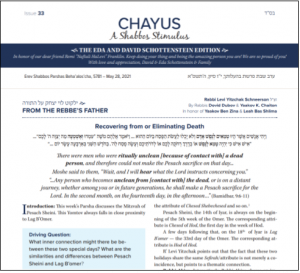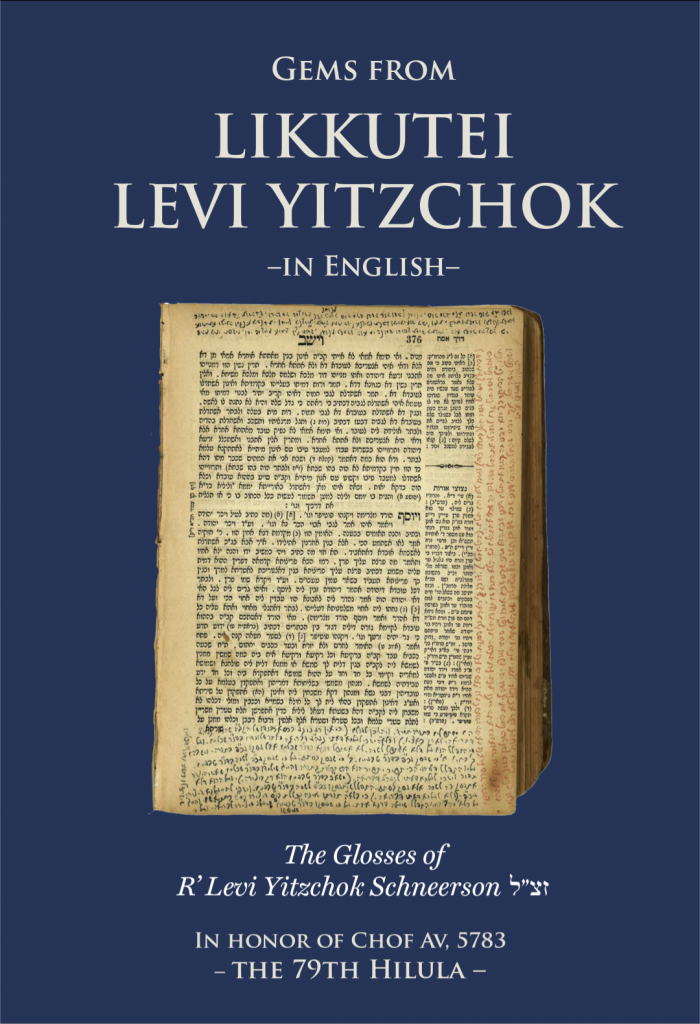BH
Likutei Levi Yitzchok
– The Teachings of R’ Levi Yitzchak Schneerson זצ”ל –
Download the Sample
Chayenu, in partnership with Rabbi Dubov, is pioneering the publication of a new weekly column featuring the mystical teachings of R’ Levi Yitzchok on the Parsha, in English,
for the first time.
-
Who was R’ Levi Yitzchok?
-
What is so unique ab
 out his approach to Torah interpretation?
out his approach to Torah interpretation?
-
What is the evolutionary process of these new translations?
-
What can we anticipate in the future?
R’ Levi Yitzchak was the illustrious father of the Lubavitcher Rebbe. A descendant of the 3rd Chabad Rebbe, known as the “Tzemach Tzedek”, he was famous in his own right, having served as the Chief Rabbi of Yekaterinoslav, Ukraine, known today as Dnipro, for some 30 years in the early 1900s.
He fought valiantly for Judaism and Jewish people’s rights under Communism and this earned him his arrest, imprisonment, then exile and ultimately his life – on 20th of Menachem Av, 5704 (1944). His tomb is near his place of exile in the city of Almaty, Kazakhstan.
A brief biography can be read here, and a more in-depth biography here.
R’ Levi Yitzchok was a true Gaon (genius) and master of Torah and a Kabbalist of epic proportions. The extent of his brilliance, in both breadth and depth of Torah knowledge – as well as his novel approach – was largely unknown until his manuscripts were discovered, deciphered and published, many years after his passing.
Although he wrote hundreds, if not thousands, of pages of Torah commentary while serving as Chief Rabbi of Yekaterinoslav, most of those have yet to be found. The vast majority of his works which survived him are the glosses he penned on the margins of the few books he had with him in exile in Chi’ili, Kazakhstan. He and his wife, Rebbetzin Chana, were so poor that she would produce ink from flowers and plants, and due to the lack of paper, he used the side margins of his few Seforim (holy books) to condense his extensive insights into a few lines or paragraphs. Rebbetzin Chana smuggled some of these volumes out of Russia. Others were retrieved later on. When these were deciphered and eventually published, the world came to know what an absolutely brilliant Torah scholar and immense Kabbalist he truly was.
The Rebbe, his son, would dedicate a talk at his Shabbos Farbrengens (Chasidic Gatherings) for many years, unpacking and demystifying his father’s often cryptic writings.

(Photo courtesy: Library of Agudas Chasidei Chabad – 770 / Kehot Publication Society. Note the different colors of ink, based on the flowers and plants used to produce the ink.)
Today, his teachings are published in a 5 volume set, known as “Likutei Levi Yitzchok / Toras Levi Yitzchok”, published by Kehot, available here.
Included in this collection are teachings on Tanach, Midrash, Mishnah, Talmud, Zohar & Tanya, as well as letters which R’ Levi Yitzchok wrote to his son, the future Lubavitcher Rebbe, sharing his deep Torah insights, as well as many personal letters to the Rebbe and Rebbetzin around auspicious days in their lives (wedding, birthdays, anniversaries, Jewish holidays) – with the Kabbalistic significance of these dates.
Over the last several years, there have been a handful of projects geared at unpacking the complex, subtle and novel teachings.
The leading and most comprehensive initiative is the “Yalkut Levi Yitzchak Al HaTorah” series, spearheaded by Rabbi Dovid Dubov of Princeton, New Jersey, which provides the basis of Chayenu’s project (more on this later).
What is so unique about his approach to Torah interpretation?
There are several aspects of novelty in R’ Levi Yitzchok’s perspective of Torah. While some of these elements have precedent with other Torah sages, the extent to which he took it is likely unprecedented. Here’s a glimpse of five areas:
The interconnectedness of all dimensions of Torah
Usually the esoteric (mystical) dimension of Torah (e.g. Kabbalah) is seen as a very different “genre” of Torah study than the legal or Halachic dimension (e.g. Talmud), each with its own definitions and constructs. They even seem – at the surface – to be entirely different “worlds”. Yet in truth, since ultimately the Torah is one, the “inner” and “outer” aspects must be complementary and totally unified. While this concept has been true forever, one can’t help but witness this truth in these teachings. The seamlessness with which R’ Levi Yitzchok alternates between Talmudic complexities and a passage from the Zohar, shedding light from one to another exhibits this truth most powerfully.
Furthermore, the four levels of Torah interpretation known as “PaRDeS” (an acronym for Pshat, Remez, Drush, Sod), referring to the literal, allegorical, metaphorical and mystical levels of Torah interpretation) are usually seen as distinct from one another, often even at odds. In R’ Levi Yitzchok’s Torah, they are all unified and complementary. The deepest Kabbalistic nuance, will show up in the simple meaning of the word, and the Gematria (numerical value / Remez) of a word will align perfectly with its literal sense.
Torah is an absolutely unified field and all aspects and dimensions must align.
The precision of every last detail in Torah
We know that every detail in Torah is precise. Nothing is incidental. But R’ Levi Yitzchak takes this to another level. When a word has a Gematria (numerical value) for example, it’s not only the total number that is an indicator but also the particular combination of letters, their order, the word’s literal meaning and Kabbalistic meaning that provide critical insight. Every single detail is part of the puzzle of solving the secret behind what’s going on.
The name of a sage being indicative of his approach
Although we find in the Talmud the concept of a person’s name being a window to their personality and character, R’ Levi Yitzchok takes this to the extreme, where the name of the sage gives us deep insight into their soul type, purpose, and Sefirah-alignment thus illuminating why they said what they said, and their perspective of Torah being influenced by that.
The location of a teaching giving a clue to its meaning
When the Zohar or Talmud tells us where a certain conversation or incident happened, this is a clue as to why this teaching was taught, and why it had to happen here. If the sages were walking on a pathway, in a cave, in a garden, whatever it is they were experiencing, no detail mentioned in Torah is unnecessary, and these help us understand the mystical element of the teaching and experience.
The Providential precision of minutiae of worldly affairs
Beyond Talmudic era tales recorded in Torah, even in modern times and in worldly, spiritually dark contexts, every detail that happens is laden with Divine purpose and precision. This is highlighted in the personal diary of R’ Levi Yitzchok where he describes his imprisonment and exile at the hands of the Communists and how each date and detail had Kabbalistic significance, despite the fact that it was executed by evildoers, because ultimately Hashem is one, and everything comes from Him. Here we witness the precision of Kabbalah, not only in Torah, but in worldly affairs to the furthest degree.
What is the evolutionary process of these new translations? 
As mentioned earlier, the Rebbe himself dedicated hundreds of hours at public gatherings (“Farbrengens”) decoding his father’s teachings, and adding his own commentary to them, too. These have been compiled into a set titled “Toras Menachem – Tiferes Levi Yitzchak”, produced by Lahak, and published by Kehot. Available here.
The most comprehensive deciphering of R’ Levi Yitzchok’s writings is being spearheaded by Rabbi Dovid Dubov of Chabad in Princeton, New Jersey. He is publishing a series of volumes titled “Yalkut Levi Yitzchok Al HaTorah” (currently 6 are in print, with a dozen more to come). Available here.
Here, he takes short paragraphs of the teachings, and decodes them in the footnotes, bringing many references, sources and commentary. This runs according to the weekly Parsha and is in Hebrew.
About 2 years ago, Rabbi Dubov began doing a weekly video, in English, explaining one of these ideas, on the weekly Parsha, each week. Around that time he approached Chayenu to work on putting it in print form, too.

Chayus
Chayenu had just launched its new product called “CHAYUS”, a weekly PDF received by email for Shabbos printout, which featured these insights from R’ Levi Yitzchok for the first time.
Archives of the past issues are available at Chayenu.org/chayus
Rabbi Yakov Chaiton worked on the initial draft for most of the editions, using the video and the Yalkut series as a starting point. Chayenu editorial worked on the final version for print.
Currently, the weekly teachings of R’ Levi Yitzchok on the Parsha are printed in the weekly Chayenu print edition Available here.
Each teaching, in addition to the English, is accompanied by a few lines of actual text from the words of R’ Levi Yitzchok, so that once you understand the concept you can learn it in his own words. This is with permission of Kehot Publication Society.
Additionally, some extra commentary is added, on occasion, as it is published in Chayenu print.
In 5781, in honor of the Yartzeit of R’ Levi Yitzchok a limited-edition “Teshura” (memento) was published, featuring 20 selections of these teachings and distributed to participants in the charter flight to R’ Levi Yitzchok’s tomb on that occasion.
A 2nd booklet – with another 20 teachings of R’ Levi Yitzchok – was published for 20 Av, 5782
A erd booklet – with another 20 teachings of R’ Levi Yitzchok – was published for 20 Av, 5783.
What can we anticipate in the future?
Our hope is to eventually produce a Sefer (holy book) with a teaching on each Parsha, as well as the festivals. Ultimately, we’d love to have a set, with several teachings on each Parsha. But one step at a time.
In the meantime, the momentum of translating R’ Levi Yitzchok on the weekly Parsha has inspired translations into other languages too. In France, R’ Levi Benesh is translating into French, and in Uruguay it’s being produced in Spanish under the supervision of R’ Mendel Shemtov.
Special thanks goes to:
- Rabbi Dubov for his much time and investment in this project.
- Rabbi Alexander Heppenheimer for many hours of translating and editing.
- Rabbi Yakov Chaiton for many hours of translating and editing.
- Yakov ben Zina & Leah bas Shlima for funding the research work of Rabbi Dubov.
- Ezzy Rappaport of Surfside, Florida for sponsoring the Memento for 20 Av, 5781, 20 Av, 5782 and 20 Av, 5783.
- Sholom & Esther Laine for sponsoring the weekly Chayenu print section.
- Kehot Publication Society for permission to include the original text.
Download the Sample

